Digital Innovation Research Paper 2022
VerifiedAdded on 2022/10/19
|12
|2597
|11
AI Summary
Contribute Materials
Your contribution can guide someone’s learning journey. Share your
documents today.
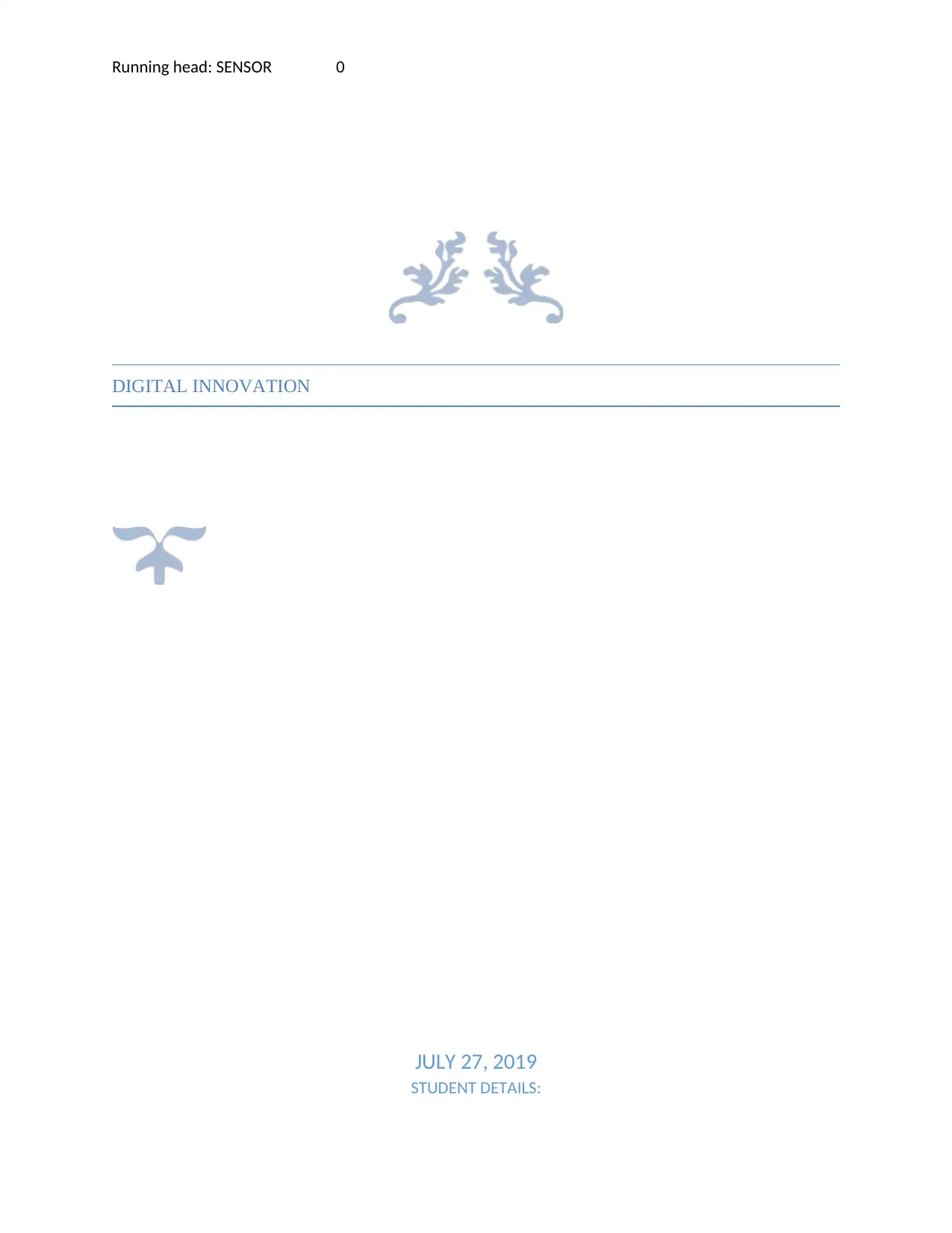
Running head: SENSOR 0
DIGITAL INNOVATION
JULY 27, 2019
STUDENT DETAILS:
DIGITAL INNOVATION
JULY 27, 2019
STUDENT DETAILS:
Secure Best Marks with AI Grader
Need help grading? Try our AI Grader for instant feedback on your assignments.
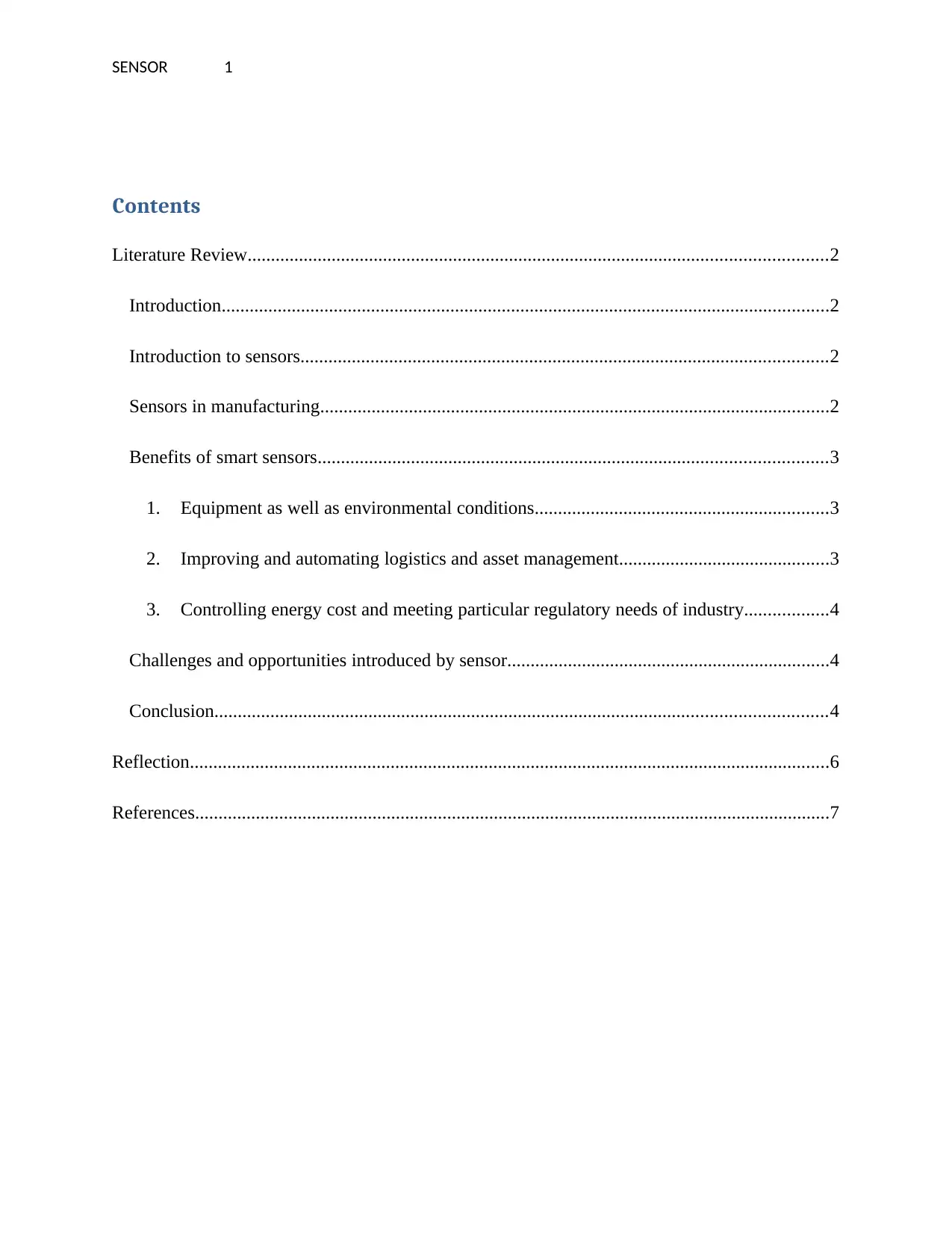
SENSOR 1
Contents
Literature Review............................................................................................................................2
Introduction..................................................................................................................................2
Introduction to sensors.................................................................................................................2
Sensors in manufacturing.............................................................................................................2
Benefits of smart sensors.............................................................................................................3
1. Equipment as well as environmental conditions...............................................................3
2. Improving and automating logistics and asset management.............................................3
3. Controlling energy cost and meeting particular regulatory needs of industry..................4
Challenges and opportunities introduced by sensor.....................................................................4
Conclusion...................................................................................................................................4
Reflection.........................................................................................................................................6
References........................................................................................................................................7
Contents
Literature Review............................................................................................................................2
Introduction..................................................................................................................................2
Introduction to sensors.................................................................................................................2
Sensors in manufacturing.............................................................................................................2
Benefits of smart sensors.............................................................................................................3
1. Equipment as well as environmental conditions...............................................................3
2. Improving and automating logistics and asset management.............................................3
3. Controlling energy cost and meeting particular regulatory needs of industry..................4
Challenges and opportunities introduced by sensor.....................................................................4
Conclusion...................................................................................................................................4
Reflection.........................................................................................................................................6
References........................................................................................................................................7
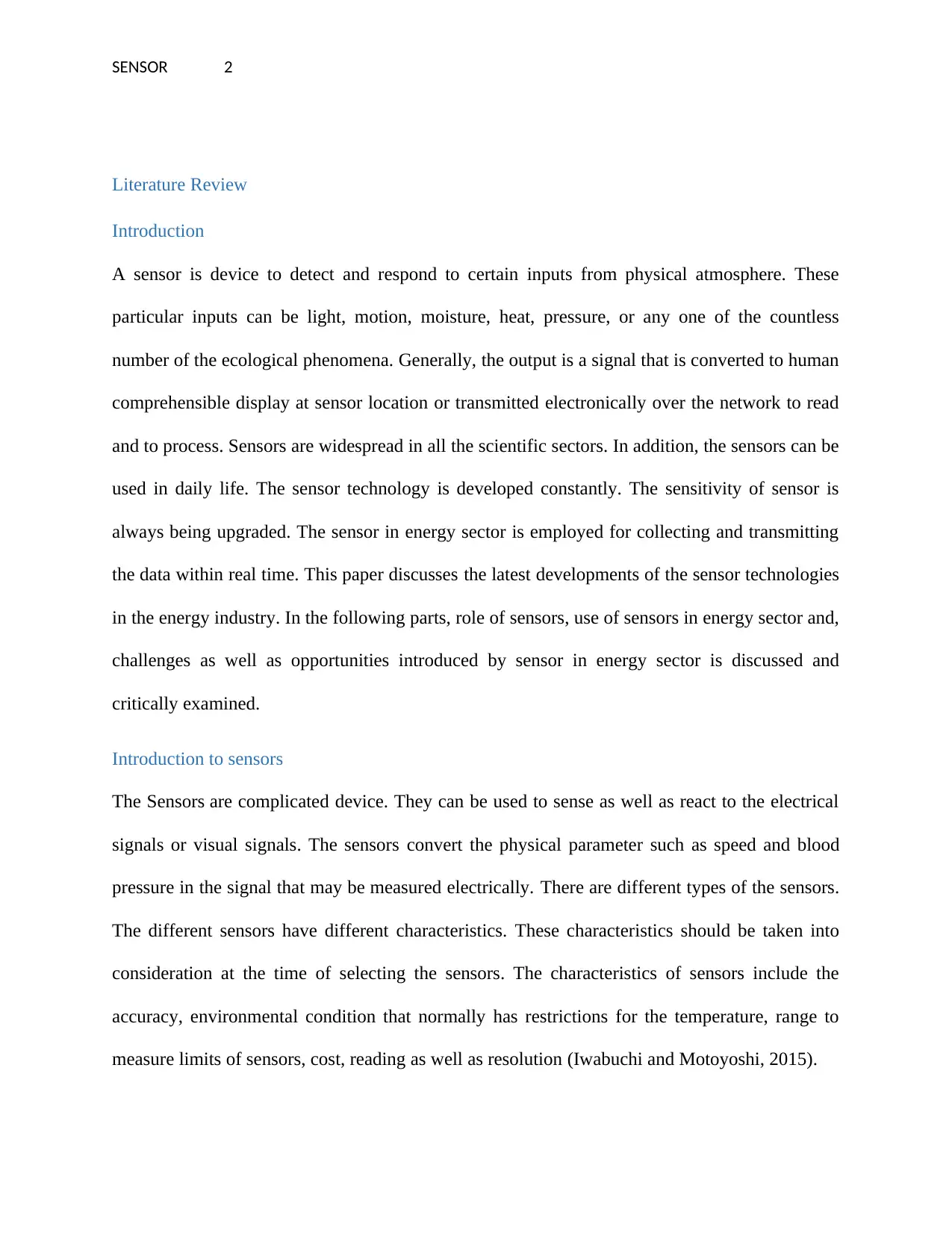
SENSOR 2
Literature Review
Introduction
A sensor is device to detect and respond to certain inputs from physical atmosphere. These
particular inputs can be light, motion, moisture, heat, pressure, or any one of the countless
number of the ecological phenomena. Generally, the output is a signal that is converted to human
comprehensible display at sensor location or transmitted electronically over the network to read
and to process. Sensors are widespread in all the scientific sectors. In addition, the sensors can be
used in daily life. The sensor technology is developed constantly. The sensitivity of sensor is
always being upgraded. The sensor in energy sector is employed for collecting and transmitting
the data within real time. This paper discusses the latest developments of the sensor technologies
in the energy industry. In the following parts, role of sensors, use of sensors in energy sector and,
challenges as well as opportunities introduced by sensor in energy sector is discussed and
critically examined.
Introduction to sensors
The Sensors are complicated device. They can be used to sense as well as react to the electrical
signals or visual signals. The sensors convert the physical parameter such as speed and blood
pressure in the signal that may be measured electrically. There are different types of the sensors.
The different sensors have different characteristics. These characteristics should be taken into
consideration at the time of selecting the sensors. The characteristics of sensors include the
accuracy, environmental condition that normally has restrictions for the temperature, range to
measure limits of sensors, cost, reading as well as resolution (Iwabuchi and Motoyoshi, 2015).
Literature Review
Introduction
A sensor is device to detect and respond to certain inputs from physical atmosphere. These
particular inputs can be light, motion, moisture, heat, pressure, or any one of the countless
number of the ecological phenomena. Generally, the output is a signal that is converted to human
comprehensible display at sensor location or transmitted electronically over the network to read
and to process. Sensors are widespread in all the scientific sectors. In addition, the sensors can be
used in daily life. The sensor technology is developed constantly. The sensitivity of sensor is
always being upgraded. The sensor in energy sector is employed for collecting and transmitting
the data within real time. This paper discusses the latest developments of the sensor technologies
in the energy industry. In the following parts, role of sensors, use of sensors in energy sector and,
challenges as well as opportunities introduced by sensor in energy sector is discussed and
critically examined.
Introduction to sensors
The Sensors are complicated device. They can be used to sense as well as react to the electrical
signals or visual signals. The sensors convert the physical parameter such as speed and blood
pressure in the signal that may be measured electrically. There are different types of the sensors.
The different sensors have different characteristics. These characteristics should be taken into
consideration at the time of selecting the sensors. The characteristics of sensors include the
accuracy, environmental condition that normally has restrictions for the temperature, range to
measure limits of sensors, cost, reading as well as resolution (Iwabuchi and Motoyoshi, 2015).
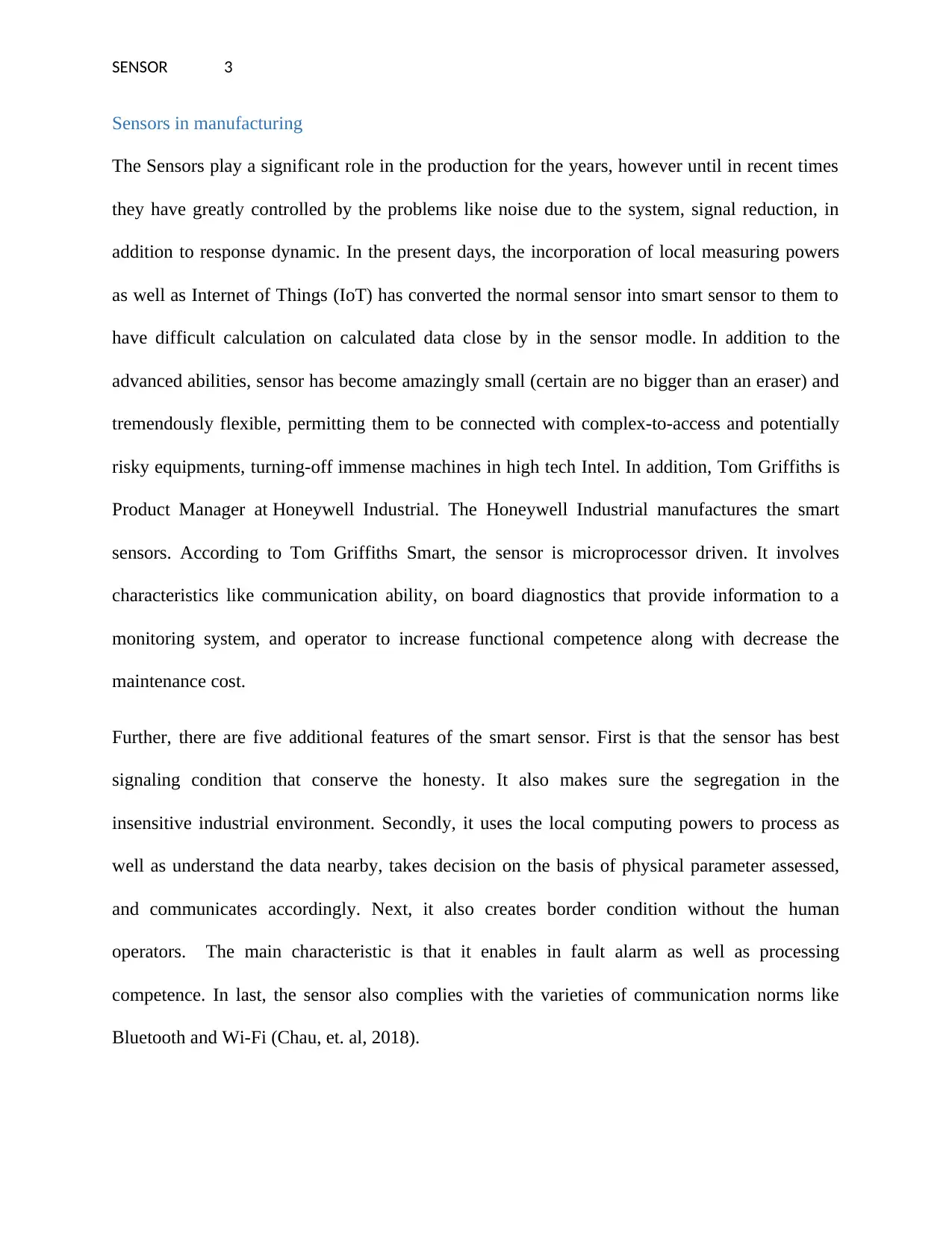
SENSOR 3
Sensors in manufacturing
The Sensors play a significant role in the production for the years, however until in recent times
they have greatly controlled by the problems like noise due to the system, signal reduction, in
addition to response dynamic. In the present days, the incorporation of local measuring powers
as well as Internet of Things (IoT) has converted the normal sensor into smart sensor to them to
have difficult calculation on calculated data close by in the sensor modle. In addition to the
advanced abilities, sensor has become amazingly small (certain are no bigger than an eraser) and
tremendously flexible, permitting them to be connected with complex-to-access and potentially
risky equipments, turning-off immense machines in high tech Intel. In addition, Tom Griffiths is
Product Manager at Honeywell Industrial. The Honeywell Industrial manufactures the smart
sensors. According to Tom Griffiths Smart, the sensor is microprocessor driven. It involves
characteristics like communication ability, on board diagnostics that provide information to a
monitoring system, and operator to increase functional competence along with decrease the
maintenance cost.
Further, there are five additional features of the smart sensor. First is that the sensor has best
signaling condition that conserve the honesty. It also makes sure the segregation in the
insensitive industrial environment. Secondly, it uses the local computing powers to process as
well as understand the data nearby, takes decision on the basis of physical parameter assessed,
and communicates accordingly. Next, it also creates border condition without the human
operators. The main characteristic is that it enables in fault alarm as well as processing
competence. In last, the sensor also complies with the varieties of communication norms like
Bluetooth and Wi-Fi (Chau, et. al, 2018).
Sensors in manufacturing
The Sensors play a significant role in the production for the years, however until in recent times
they have greatly controlled by the problems like noise due to the system, signal reduction, in
addition to response dynamic. In the present days, the incorporation of local measuring powers
as well as Internet of Things (IoT) has converted the normal sensor into smart sensor to them to
have difficult calculation on calculated data close by in the sensor modle. In addition to the
advanced abilities, sensor has become amazingly small (certain are no bigger than an eraser) and
tremendously flexible, permitting them to be connected with complex-to-access and potentially
risky equipments, turning-off immense machines in high tech Intel. In addition, Tom Griffiths is
Product Manager at Honeywell Industrial. The Honeywell Industrial manufactures the smart
sensors. According to Tom Griffiths Smart, the sensor is microprocessor driven. It involves
characteristics like communication ability, on board diagnostics that provide information to a
monitoring system, and operator to increase functional competence along with decrease the
maintenance cost.
Further, there are five additional features of the smart sensor. First is that the sensor has best
signaling condition that conserve the honesty. It also makes sure the segregation in the
insensitive industrial environment. Secondly, it uses the local computing powers to process as
well as understand the data nearby, takes decision on the basis of physical parameter assessed,
and communicates accordingly. Next, it also creates border condition without the human
operators. The main characteristic is that it enables in fault alarm as well as processing
competence. In last, the sensor also complies with the varieties of communication norms like
Bluetooth and Wi-Fi (Chau, et. al, 2018).
Secure Best Marks with AI Grader
Need help grading? Try our AI Grader for instant feedback on your assignments.
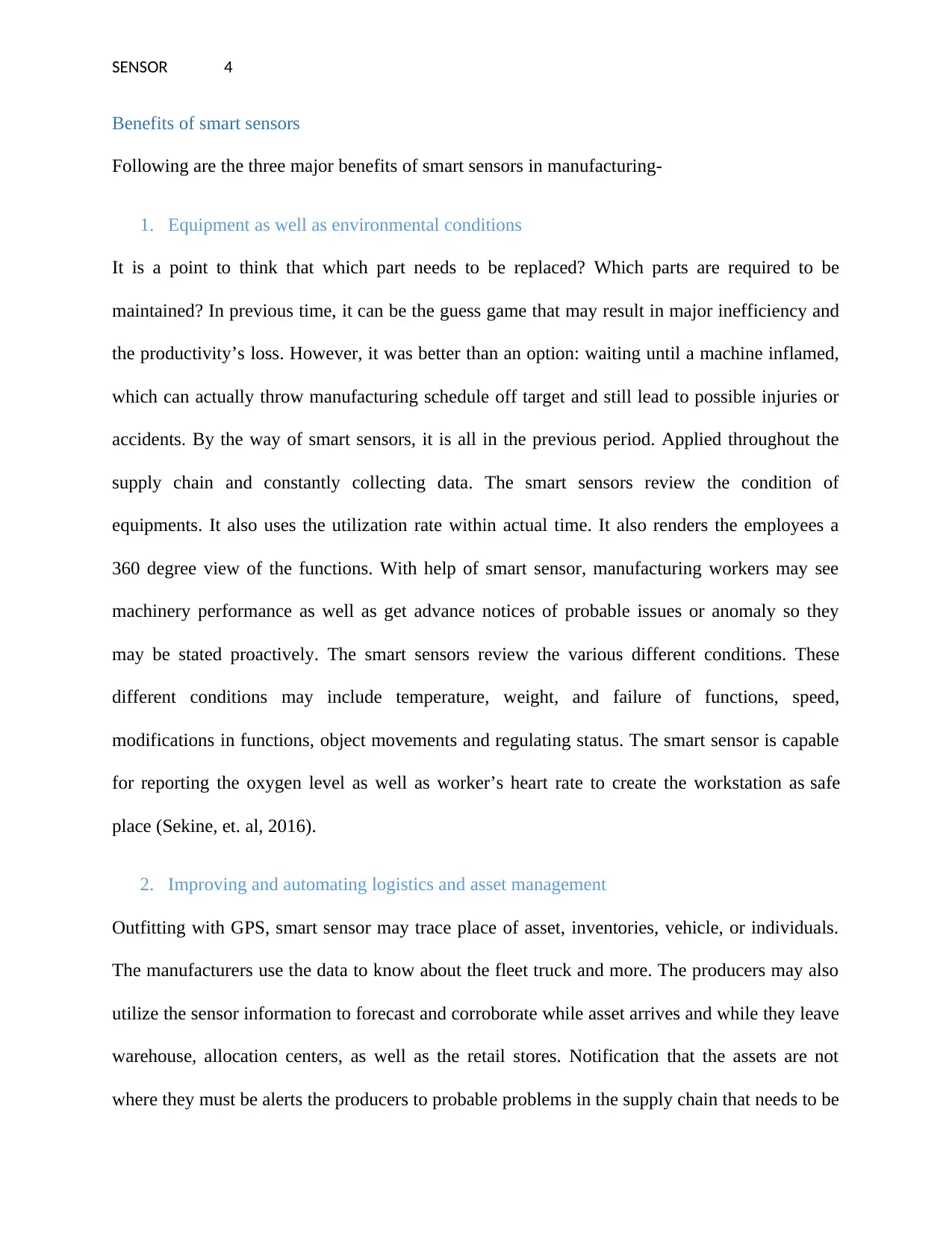
SENSOR 4
Benefits of smart sensors
Following are the three major benefits of smart sensors in manufacturing-
1. Equipment as well as environmental conditions
It is a point to think that which part needs to be replaced? Which parts are required to be
maintained? In previous time, it can be the guess game that may result in major inefficiency and
the productivity’s loss. However, it was better than an option: waiting until a machine inflamed,
which can actually throw manufacturing schedule off target and still lead to possible injuries or
accidents. By the way of smart sensors, it is all in the previous period. Applied throughout the
supply chain and constantly collecting data. The smart sensors review the condition of
equipments. It also uses the utilization rate within actual time. It also renders the employees a
360 degree view of the functions. With help of smart sensor, manufacturing workers may see
machinery performance as well as get advance notices of probable issues or anomaly so they
may be stated proactively. The smart sensors review the various different conditions. These
different conditions may include temperature, weight, and failure of functions, speed,
modifications in functions, object movements and regulating status. The smart sensor is capable
for reporting the oxygen level as well as worker’s heart rate to create the workstation as safe
place (Sekine, et. al, 2016).
2. Improving and automating logistics and asset management
Outfitting with GPS, smart sensor may trace place of asset, inventories, vehicle, or individuals.
The manufacturers use the data to know about the fleet truck and more. The producers may also
utilize the sensor information to forecast and corroborate while asset arrives and while they leave
warehouse, allocation centers, as well as the retail stores. Notification that the assets are not
where they must be alerts the producers to probable problems in the supply chain that needs to be
Benefits of smart sensors
Following are the three major benefits of smart sensors in manufacturing-
1. Equipment as well as environmental conditions
It is a point to think that which part needs to be replaced? Which parts are required to be
maintained? In previous time, it can be the guess game that may result in major inefficiency and
the productivity’s loss. However, it was better than an option: waiting until a machine inflamed,
which can actually throw manufacturing schedule off target and still lead to possible injuries or
accidents. By the way of smart sensors, it is all in the previous period. Applied throughout the
supply chain and constantly collecting data. The smart sensors review the condition of
equipments. It also uses the utilization rate within actual time. It also renders the employees a
360 degree view of the functions. With help of smart sensor, manufacturing workers may see
machinery performance as well as get advance notices of probable issues or anomaly so they
may be stated proactively. The smart sensors review the various different conditions. These
different conditions may include temperature, weight, and failure of functions, speed,
modifications in functions, object movements and regulating status. The smart sensor is capable
for reporting the oxygen level as well as worker’s heart rate to create the workstation as safe
place (Sekine, et. al, 2016).
2. Improving and automating logistics and asset management
Outfitting with GPS, smart sensor may trace place of asset, inventories, vehicle, or individuals.
The manufacturers use the data to know about the fleet truck and more. The producers may also
utilize the sensor information to forecast and corroborate while asset arrives and while they leave
warehouse, allocation centers, as well as the retail stores. Notification that the assets are not
where they must be alerts the producers to probable problems in the supply chain that needs to be
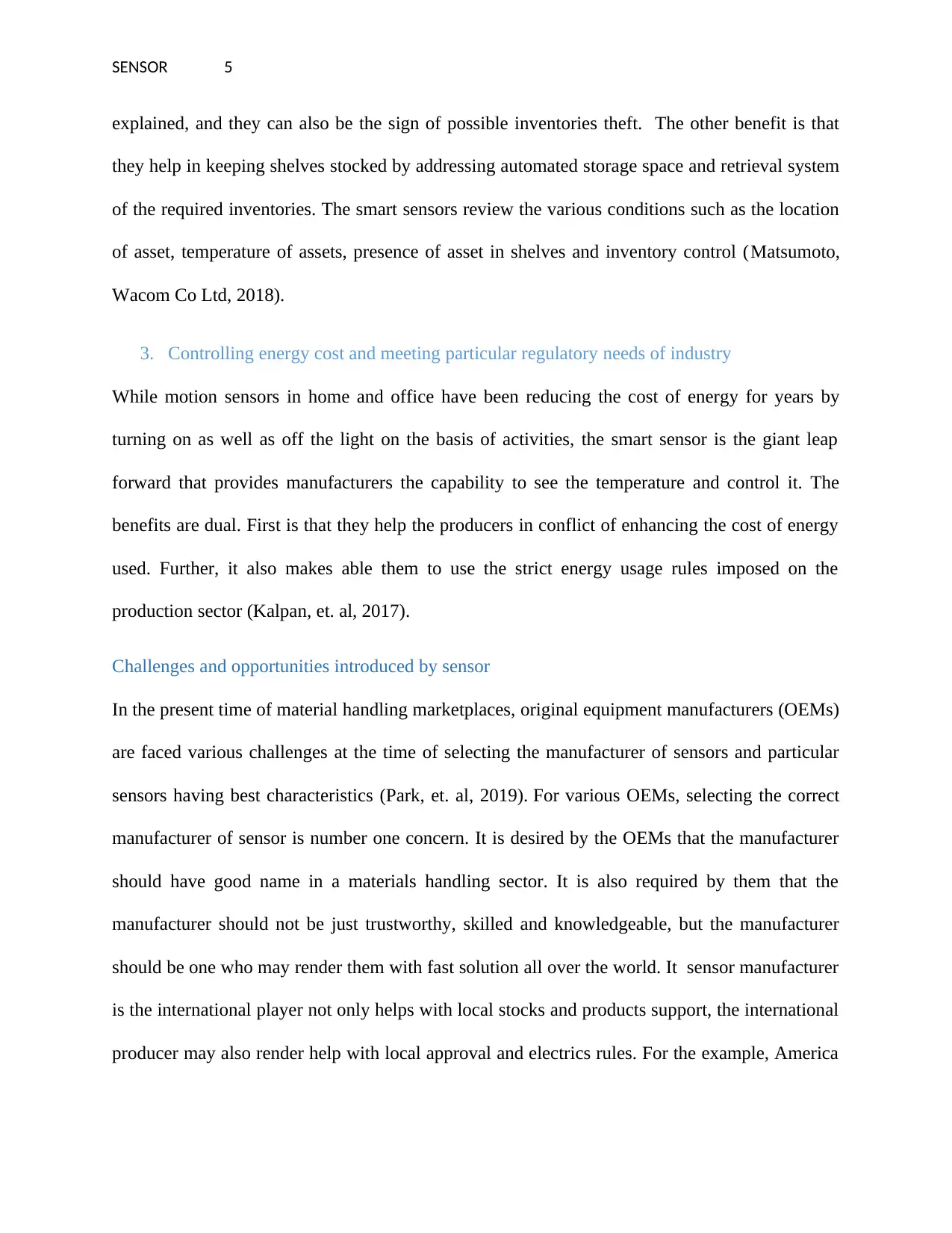
SENSOR 5
explained, and they can also be the sign of possible inventories theft. The other benefit is that
they help in keeping shelves stocked by addressing automated storage space and retrieval system
of the required inventories. The smart sensors review the various conditions such as the location
of asset, temperature of assets, presence of asset in shelves and inventory control (Matsumoto,
Wacom Co Ltd, 2018).
3. Controlling energy cost and meeting particular regulatory needs of industry
While motion sensors in home and office have been reducing the cost of energy for years by
turning on as well as off the light on the basis of activities, the smart sensor is the giant leap
forward that provides manufacturers the capability to see the temperature and control it. The
benefits are dual. First is that they help the producers in conflict of enhancing the cost of energy
used. Further, it also makes able them to use the strict energy usage rules imposed on the
production sector (Kalpan, et. al, 2017).
Challenges and opportunities introduced by sensor
In the present time of material handling marketplaces, original equipment manufacturers (OEMs)
are faced various challenges at the time of selecting the manufacturer of sensors and particular
sensors having best characteristics (Park, et. al, 2019). For various OEMs, selecting the correct
manufacturer of sensor is number one concern. It is desired by the OEMs that the manufacturer
should have good name in a materials handling sector. It is also required by them that the
manufacturer should not be just trustworthy, skilled and knowledgeable, but the manufacturer
should be one who may render them with fast solution all over the world. It sensor manufacturer
is the international player not only helps with local stocks and products support, the international
producer may also render help with local approval and electrics rules. For the example, America
explained, and they can also be the sign of possible inventories theft. The other benefit is that
they help in keeping shelves stocked by addressing automated storage space and retrieval system
of the required inventories. The smart sensors review the various conditions such as the location
of asset, temperature of assets, presence of asset in shelves and inventory control (Matsumoto,
Wacom Co Ltd, 2018).
3. Controlling energy cost and meeting particular regulatory needs of industry
While motion sensors in home and office have been reducing the cost of energy for years by
turning on as well as off the light on the basis of activities, the smart sensor is the giant leap
forward that provides manufacturers the capability to see the temperature and control it. The
benefits are dual. First is that they help the producers in conflict of enhancing the cost of energy
used. Further, it also makes able them to use the strict energy usage rules imposed on the
production sector (Kalpan, et. al, 2017).
Challenges and opportunities introduced by sensor
In the present time of material handling marketplaces, original equipment manufacturers (OEMs)
are faced various challenges at the time of selecting the manufacturer of sensors and particular
sensors having best characteristics (Park, et. al, 2019). For various OEMs, selecting the correct
manufacturer of sensor is number one concern. It is desired by the OEMs that the manufacturer
should have good name in a materials handling sector. It is also required by them that the
manufacturer should not be just trustworthy, skilled and knowledgeable, but the manufacturer
should be one who may render them with fast solution all over the world. It sensor manufacturer
is the international player not only helps with local stocks and products support, the international
producer may also render help with local approval and electrics rules. For the example, America
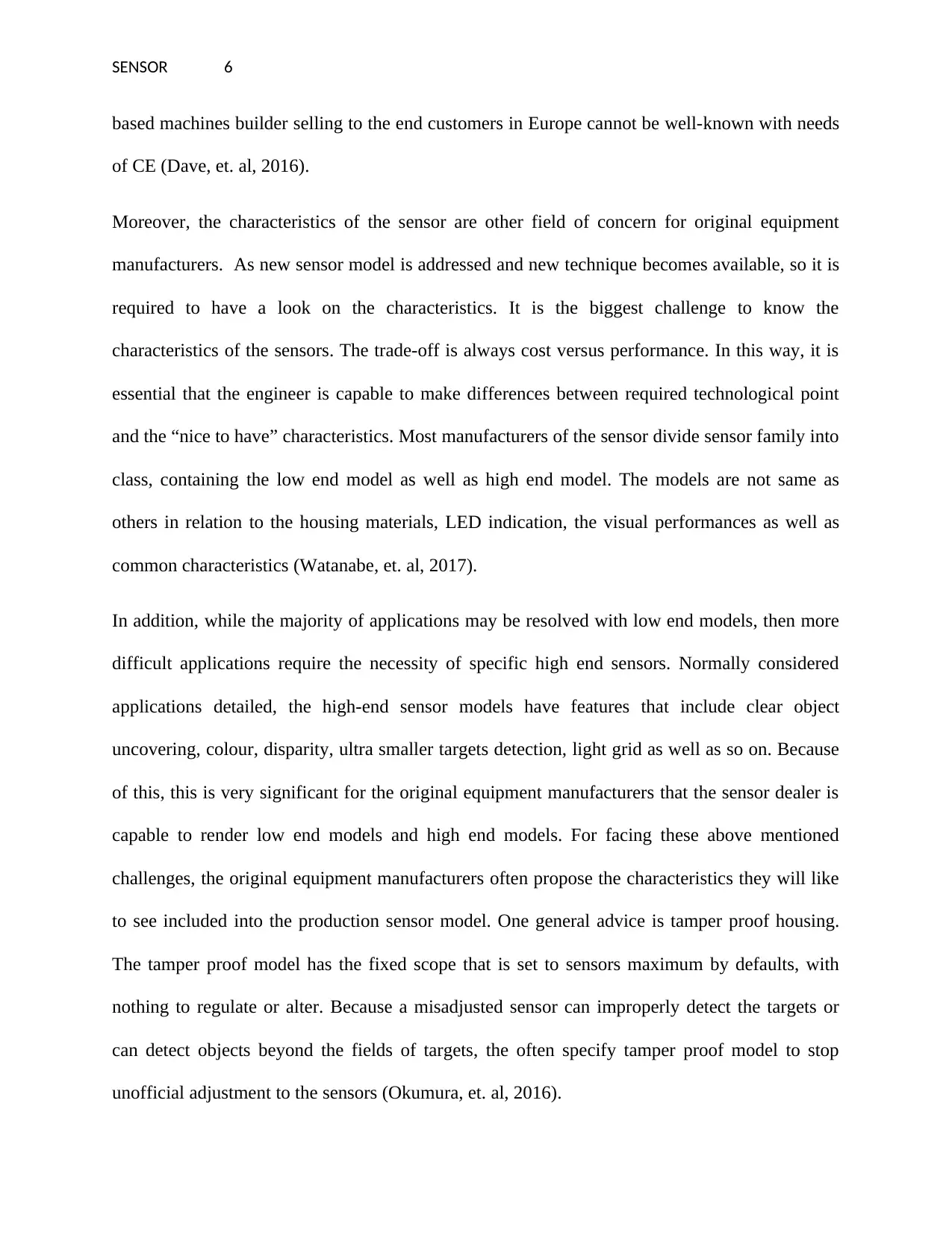
SENSOR 6
based machines builder selling to the end customers in Europe cannot be well-known with needs
of CE (Dave, et. al, 2016).
Moreover, the characteristics of the sensor are other field of concern for original equipment
manufacturers. As new sensor model is addressed and new technique becomes available, so it is
required to have a look on the characteristics. It is the biggest challenge to know the
characteristics of the sensors. The trade-off is always cost versus performance. In this way, it is
essential that the engineer is capable to make differences between required technological point
and the “nice to have” characteristics. Most manufacturers of the sensor divide sensor family into
class, containing the low end model as well as high end model. The models are not same as
others in relation to the housing materials, LED indication, the visual performances as well as
common characteristics (Watanabe, et. al, 2017).
In addition, while the majority of applications may be resolved with low end models, then more
difficult applications require the necessity of specific high end sensors. Normally considered
applications detailed, the high-end sensor models have features that include clear object
uncovering, colour, disparity, ultra smaller targets detection, light grid as well as so on. Because
of this, this is very significant for the original equipment manufacturers that the sensor dealer is
capable to render low end models and high end models. For facing these above mentioned
challenges, the original equipment manufacturers often propose the characteristics they will like
to see included into the production sensor model. One general advice is tamper proof housing.
The tamper proof model has the fixed scope that is set to sensors maximum by defaults, with
nothing to regulate or alter. Because a misadjusted sensor can improperly detect the targets or
can detect objects beyond the fields of targets, the often specify tamper proof model to stop
unofficial adjustment to the sensors (Okumura, et. al, 2016).
based machines builder selling to the end customers in Europe cannot be well-known with needs
of CE (Dave, et. al, 2016).
Moreover, the characteristics of the sensor are other field of concern for original equipment
manufacturers. As new sensor model is addressed and new technique becomes available, so it is
required to have a look on the characteristics. It is the biggest challenge to know the
characteristics of the sensors. The trade-off is always cost versus performance. In this way, it is
essential that the engineer is capable to make differences between required technological point
and the “nice to have” characteristics. Most manufacturers of the sensor divide sensor family into
class, containing the low end model as well as high end model. The models are not same as
others in relation to the housing materials, LED indication, the visual performances as well as
common characteristics (Watanabe, et. al, 2017).
In addition, while the majority of applications may be resolved with low end models, then more
difficult applications require the necessity of specific high end sensors. Normally considered
applications detailed, the high-end sensor models have features that include clear object
uncovering, colour, disparity, ultra smaller targets detection, light grid as well as so on. Because
of this, this is very significant for the original equipment manufacturers that the sensor dealer is
capable to render low end models and high end models. For facing these above mentioned
challenges, the original equipment manufacturers often propose the characteristics they will like
to see included into the production sensor model. One general advice is tamper proof housing.
The tamper proof model has the fixed scope that is set to sensors maximum by defaults, with
nothing to regulate or alter. Because a misadjusted sensor can improperly detect the targets or
can detect objects beyond the fields of targets, the often specify tamper proof model to stop
unofficial adjustment to the sensors (Okumura, et. al, 2016).
Paraphrase This Document
Need a fresh take? Get an instant paraphrase of this document with our AI Paraphraser
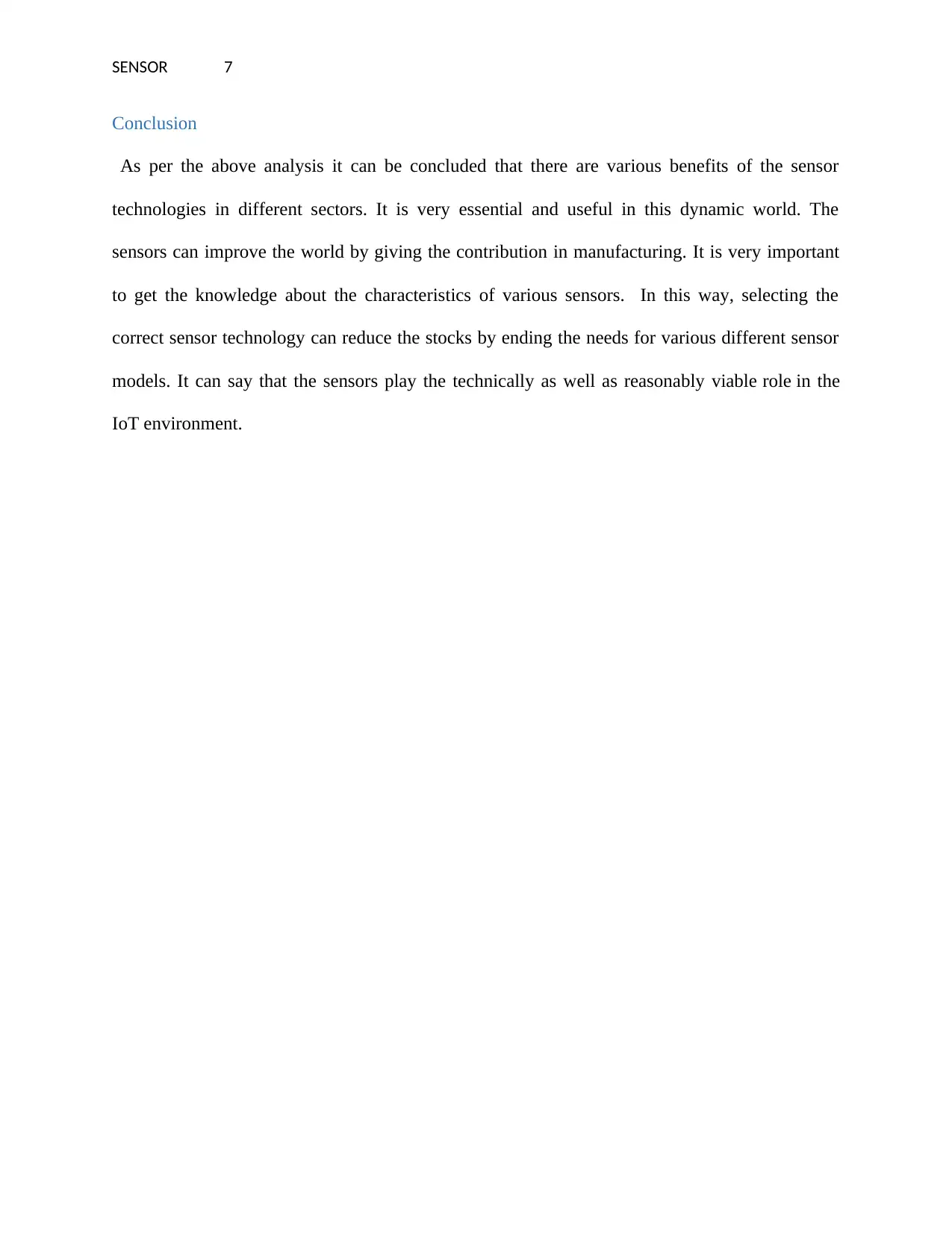
SENSOR 7
Conclusion
As per the above analysis it can be concluded that there are various benefits of the sensor
technologies in different sectors. It is very essential and useful in this dynamic world. The
sensors can improve the world by giving the contribution in manufacturing. It is very important
to get the knowledge about the characteristics of various sensors. In this way, selecting the
correct sensor technology can reduce the stocks by ending the needs for various different sensor
models. It can say that the sensors play the technically as well as reasonably viable role in the
IoT environment.
Conclusion
As per the above analysis it can be concluded that there are various benefits of the sensor
technologies in different sectors. It is very essential and useful in this dynamic world. The
sensors can improve the world by giving the contribution in manufacturing. It is very important
to get the knowledge about the characteristics of various sensors. In this way, selecting the
correct sensor technology can reduce the stocks by ending the needs for various different sensor
models. It can say that the sensors play the technically as well as reasonably viable role in the
IoT environment.
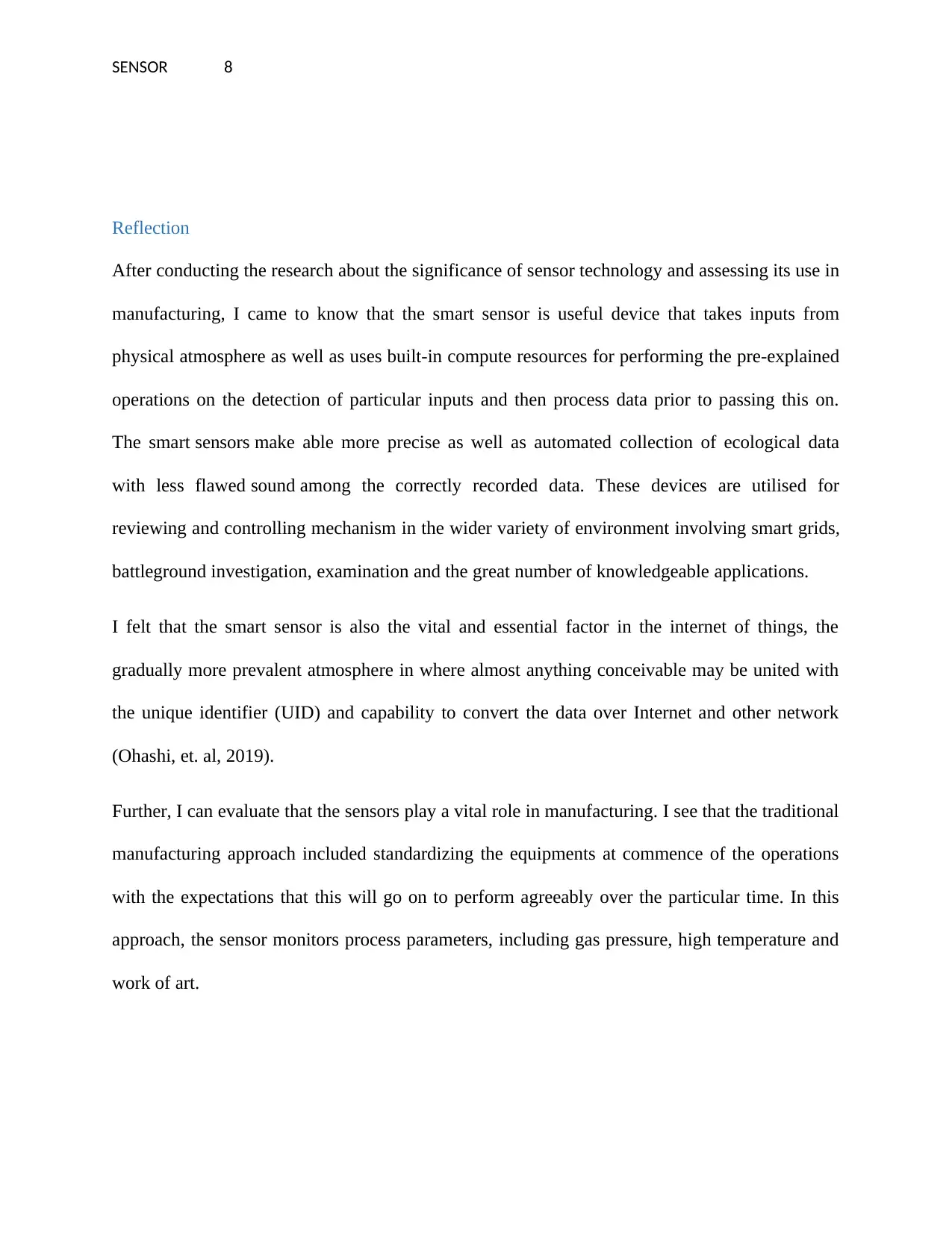
SENSOR 8
Reflection
After conducting the research about the significance of sensor technology and assessing its use in
manufacturing, I came to know that the smart sensor is useful device that takes inputs from
physical atmosphere as well as uses built-in compute resources for performing the pre-explained
operations on the detection of particular inputs and then process data prior to passing this on.
The smart sensors make able more precise as well as automated collection of ecological data
with less flawed sound among the correctly recorded data. These devices are utilised for
reviewing and controlling mechanism in the wider variety of environment involving smart grids,
battleground investigation, examination and the great number of knowledgeable applications.
I felt that the smart sensor is also the vital and essential factor in the internet of things, the
gradually more prevalent atmosphere in where almost anything conceivable may be united with
the unique identifier (UID) and capability to convert the data over Internet and other network
(Ohashi, et. al, 2019).
Further, I can evaluate that the sensors play a vital role in manufacturing. I see that the traditional
manufacturing approach included standardizing the equipments at commence of the operations
with the expectations that this will go on to perform agreeably over the particular time. In this
approach, the sensor monitors process parameters, including gas pressure, high temperature and
work of art.
Reflection
After conducting the research about the significance of sensor technology and assessing its use in
manufacturing, I came to know that the smart sensor is useful device that takes inputs from
physical atmosphere as well as uses built-in compute resources for performing the pre-explained
operations on the detection of particular inputs and then process data prior to passing this on.
The smart sensors make able more precise as well as automated collection of ecological data
with less flawed sound among the correctly recorded data. These devices are utilised for
reviewing and controlling mechanism in the wider variety of environment involving smart grids,
battleground investigation, examination and the great number of knowledgeable applications.
I felt that the smart sensor is also the vital and essential factor in the internet of things, the
gradually more prevalent atmosphere in where almost anything conceivable may be united with
the unique identifier (UID) and capability to convert the data over Internet and other network
(Ohashi, et. al, 2019).
Further, I can evaluate that the sensors play a vital role in manufacturing. I see that the traditional
manufacturing approach included standardizing the equipments at commence of the operations
with the expectations that this will go on to perform agreeably over the particular time. In this
approach, the sensor monitors process parameters, including gas pressure, high temperature and
work of art.
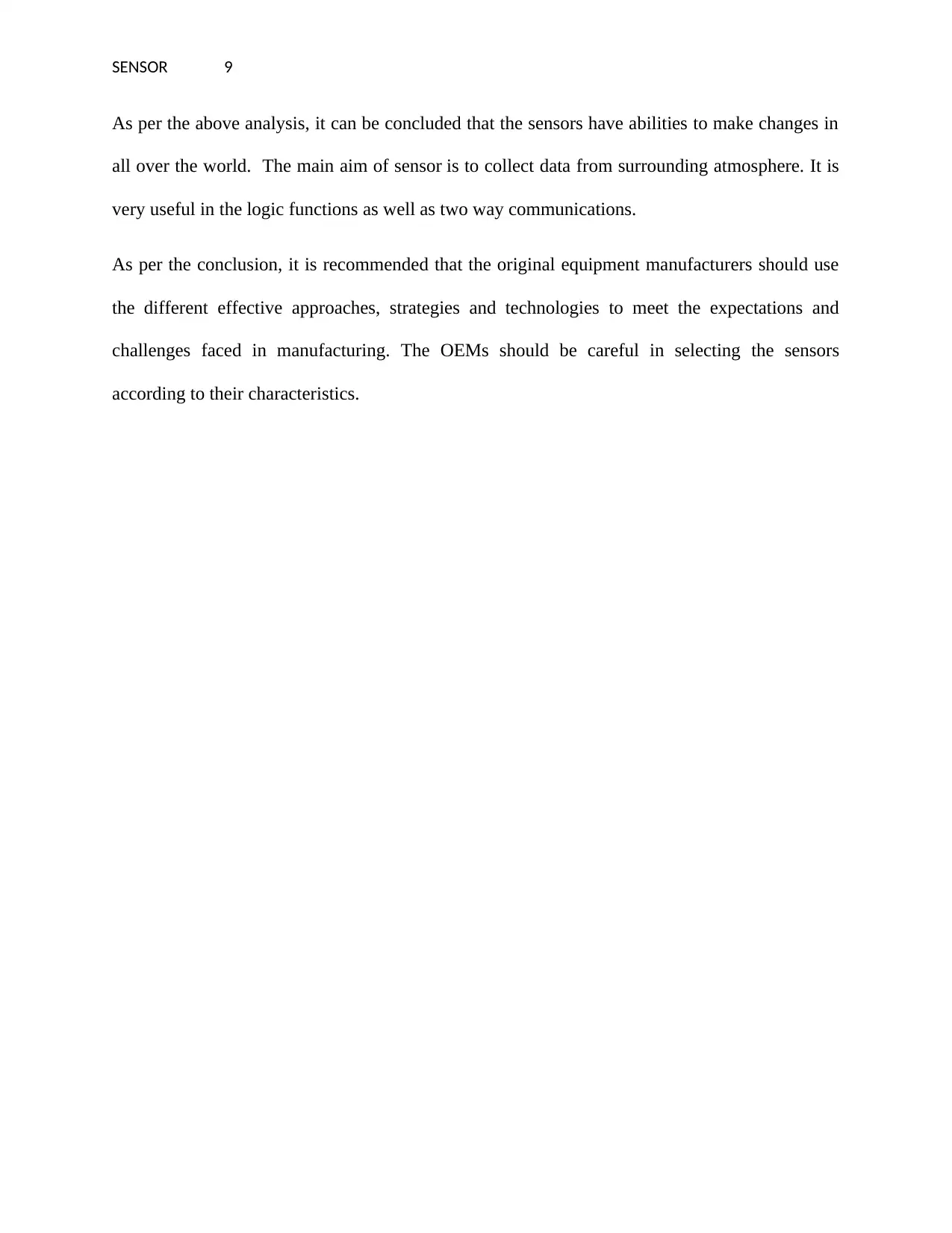
SENSOR 9
As per the above analysis, it can be concluded that the sensors have abilities to make changes in
all over the world. The main aim of sensor is to collect data from surrounding atmosphere. It is
very useful in the logic functions as well as two way communications.
As per the conclusion, it is recommended that the original equipment manufacturers should use
the different effective approaches, strategies and technologies to meet the expectations and
challenges faced in manufacturing. The OEMs should be careful in selecting the sensors
according to their characteristics.
As per the above analysis, it can be concluded that the sensors have abilities to make changes in
all over the world. The main aim of sensor is to collect data from surrounding atmosphere. It is
very useful in the logic functions as well as two way communications.
As per the conclusion, it is recommended that the original equipment manufacturers should use
the different effective approaches, strategies and technologies to meet the expectations and
challenges faced in manufacturing. The OEMs should be careful in selecting the sensors
according to their characteristics.
Secure Best Marks with AI Grader
Need help grading? Try our AI Grader for instant feedback on your assignments.
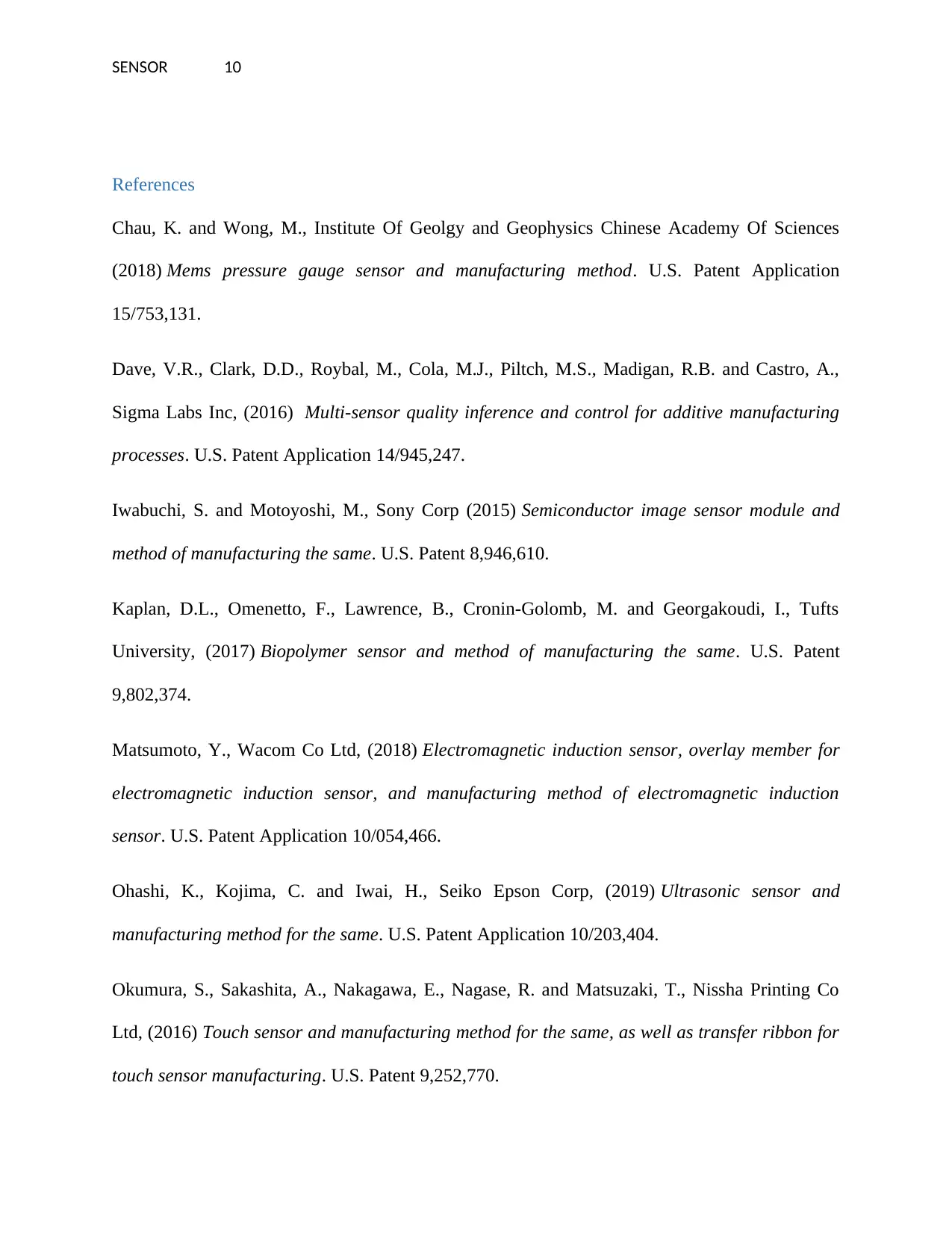
SENSOR 10
References
Chau, K. and Wong, M., Institute Of Geolgy and Geophysics Chinese Academy Of Sciences
(2018) Mems pressure gauge sensor and manufacturing method. U.S. Patent Application
15/753,131.
Dave, V.R., Clark, D.D., Roybal, M., Cola, M.J., Piltch, M.S., Madigan, R.B. and Castro, A.,
Sigma Labs Inc, (2016) Multi-sensor quality inference and control for additive manufacturing
processes. U.S. Patent Application 14/945,247.
Iwabuchi, S. and Motoyoshi, M., Sony Corp (2015) Semiconductor image sensor module and
method of manufacturing the same. U.S. Patent 8,946,610.
Kaplan, D.L., Omenetto, F., Lawrence, B., Cronin-Golomb, M. and Georgakoudi, I., Tufts
University, (2017) Biopolymer sensor and method of manufacturing the same. U.S. Patent
9,802,374.
Matsumoto, Y., Wacom Co Ltd, (2018) Electromagnetic induction sensor, overlay member for
electromagnetic induction sensor, and manufacturing method of electromagnetic induction
sensor. U.S. Patent Application 10/054,466.
Ohashi, K., Kojima, C. and Iwai, H., Seiko Epson Corp, (2019) Ultrasonic sensor and
manufacturing method for the same. U.S. Patent Application 10/203,404.
Okumura, S., Sakashita, A., Nakagawa, E., Nagase, R. and Matsuzaki, T., Nissha Printing Co
Ltd, (2016) Touch sensor and manufacturing method for the same, as well as transfer ribbon for
touch sensor manufacturing. U.S. Patent 9,252,770.
References
Chau, K. and Wong, M., Institute Of Geolgy and Geophysics Chinese Academy Of Sciences
(2018) Mems pressure gauge sensor and manufacturing method. U.S. Patent Application
15/753,131.
Dave, V.R., Clark, D.D., Roybal, M., Cola, M.J., Piltch, M.S., Madigan, R.B. and Castro, A.,
Sigma Labs Inc, (2016) Multi-sensor quality inference and control for additive manufacturing
processes. U.S. Patent Application 14/945,247.
Iwabuchi, S. and Motoyoshi, M., Sony Corp (2015) Semiconductor image sensor module and
method of manufacturing the same. U.S. Patent 8,946,610.
Kaplan, D.L., Omenetto, F., Lawrence, B., Cronin-Golomb, M. and Georgakoudi, I., Tufts
University, (2017) Biopolymer sensor and method of manufacturing the same. U.S. Patent
9,802,374.
Matsumoto, Y., Wacom Co Ltd, (2018) Electromagnetic induction sensor, overlay member for
electromagnetic induction sensor, and manufacturing method of electromagnetic induction
sensor. U.S. Patent Application 10/054,466.
Ohashi, K., Kojima, C. and Iwai, H., Seiko Epson Corp, (2019) Ultrasonic sensor and
manufacturing method for the same. U.S. Patent Application 10/203,404.
Okumura, S., Sakashita, A., Nakagawa, E., Nagase, R. and Matsuzaki, T., Nissha Printing Co
Ltd, (2016) Touch sensor and manufacturing method for the same, as well as transfer ribbon for
touch sensor manufacturing. U.S. Patent 9,252,770.
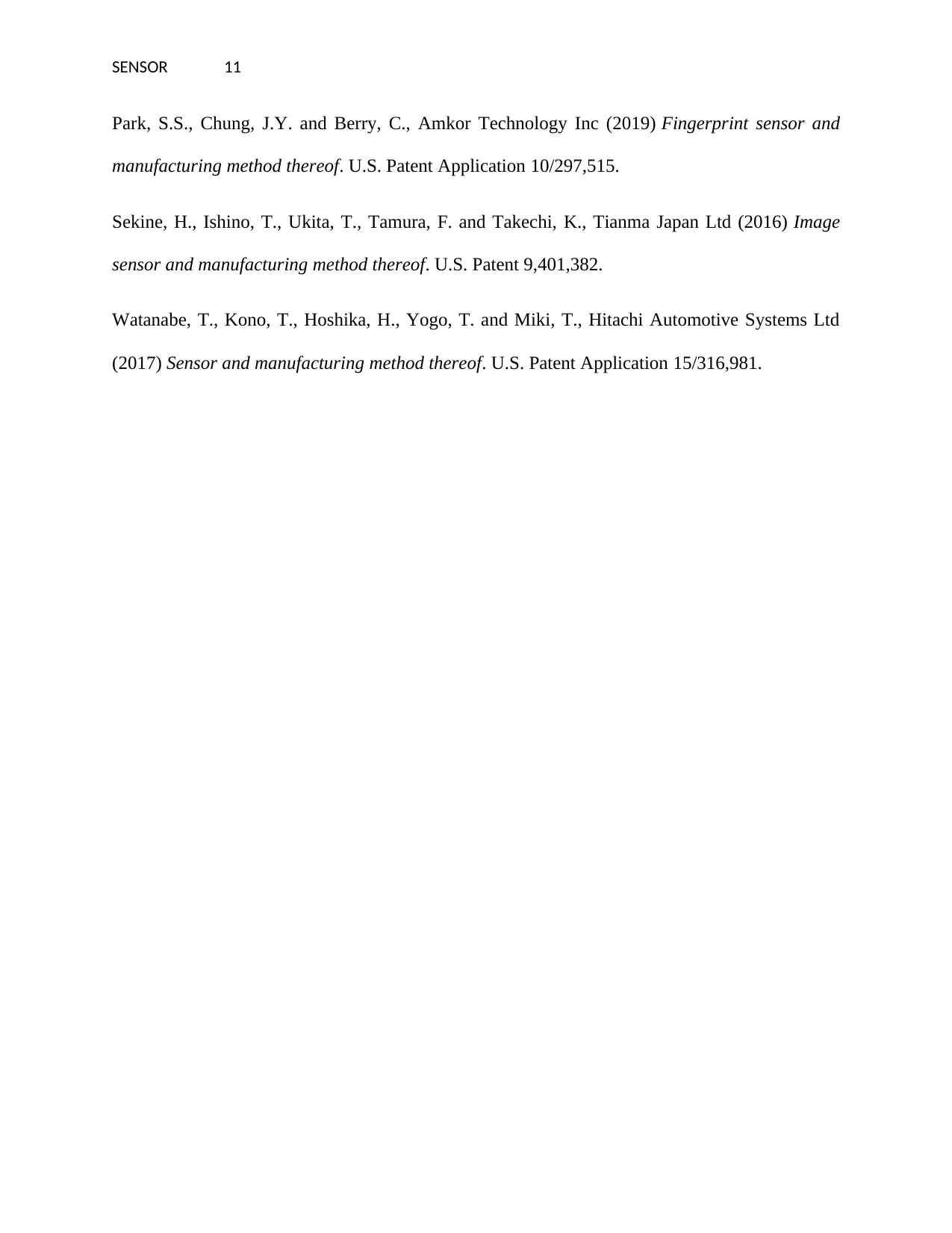
SENSOR 11
Park, S.S., Chung, J.Y. and Berry, C., Amkor Technology Inc (2019) Fingerprint sensor and
manufacturing method thereof. U.S. Patent Application 10/297,515.
Sekine, H., Ishino, T., Ukita, T., Tamura, F. and Takechi, K., Tianma Japan Ltd (2016) Image
sensor and manufacturing method thereof. U.S. Patent 9,401,382.
Watanabe, T., Kono, T., Hoshika, H., Yogo, T. and Miki, T., Hitachi Automotive Systems Ltd
(2017) Sensor and manufacturing method thereof. U.S. Patent Application 15/316,981.
Park, S.S., Chung, J.Y. and Berry, C., Amkor Technology Inc (2019) Fingerprint sensor and
manufacturing method thereof. U.S. Patent Application 10/297,515.
Sekine, H., Ishino, T., Ukita, T., Tamura, F. and Takechi, K., Tianma Japan Ltd (2016) Image
sensor and manufacturing method thereof. U.S. Patent 9,401,382.
Watanabe, T., Kono, T., Hoshika, H., Yogo, T. and Miki, T., Hitachi Automotive Systems Ltd
(2017) Sensor and manufacturing method thereof. U.S. Patent Application 15/316,981.
1 out of 12
Related Documents
Your All-in-One AI-Powered Toolkit for Academic Success.
+13062052269
info@desklib.com
Available 24*7 on WhatsApp / Email
![[object Object]](/_next/static/media/star-bottom.7253800d.svg)
Unlock your academic potential
© 2024 | Zucol Services PVT LTD | All rights reserved.



